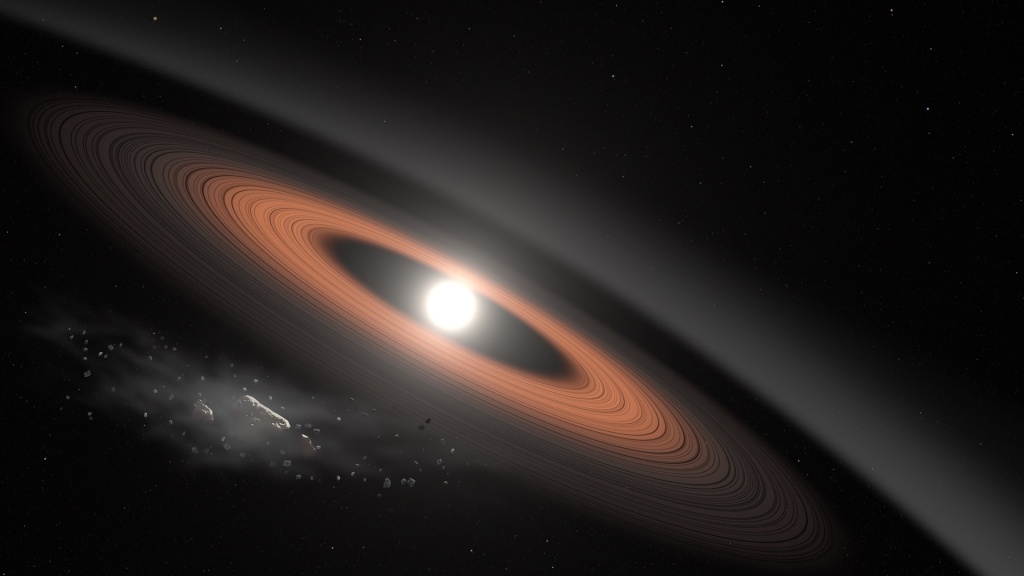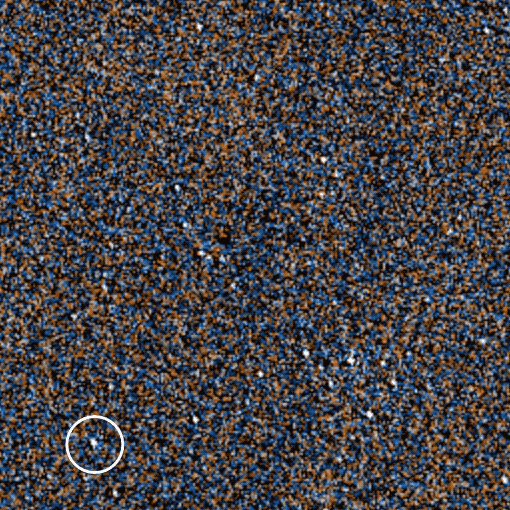Maunakea, Hawaii – A volunteer working with the NASA-led Backyard Worlds: Planet 9 project has found the oldest and coldest known white dwarf — an Earth-sized remnant of a Sun-like star that has died — ringed by dust and debris. Astronomers suspect this could be the first known white dwarf with multiple dust rings.
The star, named LSPM J0207+3331 or J0207 for short, is forcing researchers to reconsider models of planetary systems and could help us learn about the distant future of our solar system.
“This white dwarf is so old that whatever process is feeding material into its rings must operate on billion-year timescales,” said lead author John Debes, an astronomer at the Space Telescope Science Institute in Baltimore. “Most of the models scientists have created to explain rings around white dwarfs only work well up to around 100 million years, so this star is really challenging our assumptions of how planetary systems evolve.”
A paper detailing the findings was published in the Feb. 19 issue of The Astrophysical Journal Letters and is now available online.
W. M. Keck Observatory on Maunakea, Hawaii helped confirm the record-setting properties of J0207, marking first science for its newly-commissioned Near-Infrared Echellette Spectrometer (NIRES). The instrument allowed the team to identify the discovery as a cool white dwarf, and accurately determine the structure of its disk.
“The Keck observations were critical to determine the nature of this remarkable system,” said co-author Adam Burgasser of the University of California, San Diego who regularly uses Keck Observatory to study cold brown dwarfs. “The new, very sensitive NIRES instrument allowed us to identify the source as a white dwarf and rule out its extra reddening as being due to a brown dwarf companion. For once, I was happy to not find a brown dwarf!”

J0207 is located around 145 light-years away in the constellation Capricornus. White dwarfs slowly cool as they age, and Debes’ team calculated J0207 is about 3 billion years old based on a temperature just over 10,500 degrees Fahrenheit (5,800 degrees Celsius). A strong infrared signal picked up by NASA’s Wide-field Infrared Survey Explorer (WISE) mission — which mapped the entire sky in infrared light — suggested the presence of dust, making J0207 the oldest and coldest white dwarf with dust yet known. Previously, dust disks and rings had only been observed surrounding white dwarfs about one-third J0207’s age.
When a Sun-like star runs out of fuel, it swells into a red giant, ejects at least half of its mass, and leaves behind a very hot white dwarf. Over the course of the star’s giant phase, planets and asteroids close to the star become engulfed and incinerated. Planets and asteroids farther away survive, but move outward as their orbits expand. That’s because when the star loses mass, its gravitational influence on surrounding objects is greatly reduced.
This scenario describes the future of our solar system. Around 5 billion years from now, Mercury, then Venus and possibly Earth will be swallowed when the Sun grows into a red giant. Over hundreds of thousands to millions of years, the inner solar system will be scrubbed clean, and the remaining planets will drift outward.
Yet some white dwarfs — between 1 and 4 percent — show infrared emission indicating they’re surrounded by dusty disks or rings. Scientists think the dust may arise from distant asteroids and comets kicked closer to the star by gravitational interactions with displaced planets. As these small bodies approach the white dwarf, the star’s strong gravity tears them apart in a process called tidal disruption. The debris forms a ring of dust that will slowly spiral down onto the surface of the star.
J0207 was found through Backyard Worlds: Planet 9, a project led by Marc Kuchner, a co-author and astrophysicist at NASA’s Goddard Space Flight Center in Greenbelt, Maryland, that asks volunteers to sort through WISE data for new discoveries.
Melina Thévenot, a co-author and citizen scientist in Germany working with the project, initially thought the infrared signal was bad data. She was searching through the ESA’s (European Space Agency’s) Gaia archives for brown dwarfs, objects too large to be planets and too small to be stars, when she noticed J0207. When she looked at the source in the WISE infrared data, it was too bright and too far away to be a brown dwarf. Thévenot passed her findings along to the Backyard Worlds: Planet 9 team. Debes and Kuchner contacted collaborator Burgasser to obtain follow-up observations using NIRES on the Keck II telescope.
“That is a really motivating aspect of the search,” said Thévenot, one of more than 150,000 citizen scientists on the Backyard Worlds project. “The researchers will move their telescopes to look at worlds you have discovered. What I especially enjoy, though, is the interaction with the awesome research team. Everyone is very kind, and they are always trying to make the best out of our discoveries.”
Now scientists are left to puzzle how the star fits into their models.
Debes compared the population of asteroid belt analogs in white dwarf systems to the grains of sand in an hourglass. Initially, there’s a steady stream of material. The planets fling asteroids inward towards the white dwarf to be torn apart, maintaining a dusty disk. But over time, the asteroid belts become depleted, just like grains of sand in the hourglass. Eventually, all the material in the disk falls down onto the surface of the white dwarf, so older white dwarfs like J0207 should be less likely to have disks or rings.
J0207’s ring may even be multiple rings. Debes and his colleagues suggest there could be two distinct components, one thin ring just at the point where the star’s tides break up the asteroids and a wider ring closer to the white dwarf. Follow-up with future missions like NASA’s James Webb Space Telescope may help astronomers tease apart the ring’s constituent parts.

“We built Backyard Worlds: Planet 9 mostly to search for brown dwarfs and new planets in the solar system,” Kuchner said. “But working with citizen scientists always leads to surprises. They are voracious — the project just celebrated its second birthday, and they’ve already discovered more than 1,000 likely brown dwarfs. Now that we’ve rebooted the website with double the amount of WISE data, we’re looking forward to even more exciting discoveries.”
ABOUT BACKYARD WORLDS: PLANET 9
Backyard Worlds: Planet 9 is a collaboration between NASA, the American Museum of Natural History in New York, Arizona State University, National Optical Astronomy Observatory, the Space Telescope Science Institute in Baltimore, the University of California San Diego, Bucknell University, the University of Oklahoma, and Zooniverse, a collaboration of scientists, software developers and educators who collectively develop and manage citizen science projects on the internet. For more information about Backyard Worlds: Planet 9, visit: http://backyardworlds.org
ABOUT NASA’S WISE MISSION
NASA’s Jet Propulsion Laboratory in Pasadena, California, manages and operates WISE for NASA’s Science Mission Directorate. The WISE mission was selected competitively under NASA’s Explorers Program managed by the agency’s Goddard Space Flight Center. The science instrument was built by the Space Dynamics Laboratory in Logan, Utah. The spacecraft was built by Ball Aerospace & Technologies Corp. in Boulder, Colorado. Placed in hibernation in 2011, the spacecraft was reactivated in 2013 and renamed NEOWISE. Science operations and data processing take place at the Infrared Processing and Analysis Center at Caltech, which manages JPL for NASA. For more information about NASA’s WISE mission, visit: http://www.nasa.gov/wise
ABOUT W. M. KECK OBSERVATORY
The W. M. Keck Observatory telescopes are the most scientifically productive on Earth. The two, 10-meter optical/infrared telescopes atop Maunakea on the Island of Hawaii feature a suite of advanced instruments including imagers, multi-object spectrographs, high-resolution spectrographs, integral-field spectrometers, and world-leading laser guide star adaptive optics systems. The data presented herein were obtained at the W. M. Keck Observatory, which is operated as a scientific partnership among the California Institute of Technology, the University of California, and the National Aeronautics and Space Administration. The Observatory was made possible by the generous financial support of the W. M. Keck Foundation. The authors recognize and acknowledge the very significant cultural role that the summit of Maunakea has always had within the Native Hawaiian community. We are most fortunate to have the opportunity to conduct observations from this mountain.


